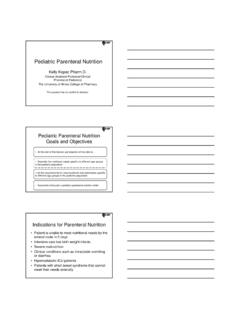Transcription of CHAPTER 12 M N - NCERT
1 194 BIOLOGY. C HAPTER 12. MINERAL N UTRITION. Methods to The basic needs of all living organisms are essentially the same. They Study the require macromolecules, such as carbohydrates, proteins and fats, and Mineral water and minerals for their growth and development. Requirements of This CHAPTER focusses mainly on inorganic plant nutrition, wherein Plants you will study the methods to identify elements essential to growth and Essential development of plants and the criteria for establishing the essentiality. Mineral You will also study the role of the essential elements, their major deficiency Elements symptoms and the mechanism of absorption of these essential elements.
2 Mechanism of The CHAPTER also introduces you briefly to the significance and the Absorption of mechanism of biological nitrogen fixation. Elements Translocation of METHODS TO STUDY THE MINERAL REQUIREMENTS OF PLANTS. Solutes Soil as Reservoir In 1860, Julius von Sachs, a prominent German botanist, demonstrated, of Essential for the first time, that plants could be grown to maturity in a defined Elements nutrient solution in complete absence of soil. This technique of growing Metabolism of plants in a nutrient solution is known as hydroponics. Since then, a Nitrogen number of improvised methods have been employed to try and determine the mineral nutrients essential for plants.
3 The essence of all these methods involves the culture of plants in a soil-free, defined mineral solution. These methods require purified water and mineral nutrient salts. Can you explain why is this so essential? After a series of experiments in which the roots of the plants were immersed in nutrient solutions and wherein an element was added /. substituted / removed or given in varied concentration, a mineral solution 2021-22. MINERAL NUTRITION 195. suitable for the plant growth was obtained. By this method, essential elements were identified and their deficiency symptoms discovered. Hydroponics has been successfully employed as a technique for the commercial production of vegetables such as tomato, seedless cucumber and lettuce.
4 It must be emphasised that the nutrient solutions must be adequately aerated to obtain the optimum growth. What would happen if solutions were poorly aerated? Diagrammatic views of the hydroponic technique is given in Figures and ESSENTIAL MINERAL ELEMENTS. Figure Diagram of a typical set-up for Most of the minerals present in soil can enter plants nutrient solution culture through roots. In fact, more than sixty elements of the 105 discovered so far are found in different plants. Some plant species accumulate selenium, some others gold, while some plants growing near nuclear test sites take up radioactive strontium.
5 There are techniques that are able to detect the minerals even at a very low concentration (10-8 g/. mL). The question is, whether all the diverse mineral elements present in a plant, for example, gold and selenium as mentioned above, are really necessary for plants? How do we decide what is essential for plants and what is not? Criteria for Essentiality The criteria for essentiality of an element are given Nutrient below: solution Pump (a) The element must be absolutely necessary for Figure Hydroponic plant production. supporting normal growth and reproduction. Plants are grown in a tube or trough placed on a slight In the absence of the element the plants do not incline.
6 A pump circulates a complete their life cycle or set the seeds. nutrient solution from a (b) The requirement of the element must be specific reservoir to the elevated end of the tube. The solution flows and not replaceable by another element. In down the tube and returns to other words, deficiency of any one element the reservoir due to gravity. cannot be met by supplying some other Inset shows a plant whose element. roots are continuously bathed in aerated nutrient solution. (c) The element must be directly involved in the The arrows indicates the metabolism of the plant. direction of the flow.
7 2021-22. 196 BIOLOGY. Based upon the above criteria only a few elements have been found to be absolutely essential for plant growth and metabolism. These elements are further divided into two broad categories based on their quantitative requirements. (i) macronutrients , and (ii) Micronutrients macronutrients are generally present in plant tissues in large amounts (in excess of 10 mmole Kg 1 of dry matter). The macronutrients include carbon, hydrogen, oxygen, nitrogen, phosphorous, sulphur, potassium, calcium and magnesium. Of these, carbon, hydrogen and oxygen are mainly obtained from CO2 and H2O, while the others are absorbed from the soil as mineral nutrition.
8 Micronutrients or trace elements, are needed in very small amounts (less than 10 mmole Kg 1 of dry matter). These include iron, manganese, copper, molybdenum, zinc, boron, chlorine and nickel. In addition to the 17 essential elements named above, there are some beneficial elements such as sodium, silicon, cobalt and selenium. They are required by higher plants. Essential elements can also be grouped into four broad categories on the basis of their diverse functions. These categories are: (i) Essential elements as components of biomolecules and hence structural elements of cells ( , carbon, hydrogen, oxygen and nitrogen).
9 (ii) Essential elements that are components of energy-related chemical compounds in plants ( , magnesium in chlorophyll and phosphorous in ATP). (iii) Essential elements that activate or inhibit enzymes, for example Mg2+ is an activator for both ribulose bisphosphate carboxylase- oxygenase and phosphoenol pyruvate carboxylase, both of which are critical enzymes in photosynthetic carbon fixation; Zn2+ is an activator of alcohol dehydrogenase and Mo of nitrogenase during nitrogen metabolism. Can you name a few more elements that fall in this category? For this, you will need to recollect some of the biochemical pathways you have studied earlier.
10 (iv) Some essential elements can alter the osmotic potential of a cell. Potassium plays an important role in the opening and closing of stomata. You may recall the role of minerals as solutes in determining the water potential of a cell. Role of Macro- and Micro-nutrients Essential elements perform several functions. They participate in various metabolic processes in the plant cells such as permeability of cell 2021-22. MINERAL NUTRITION 197. membrane, maintenance of osmotic concentration of cell sap, electron- transport systems, buffering action, enzymatic activity and act as major constituents of macromolecules and co-enzymes.















